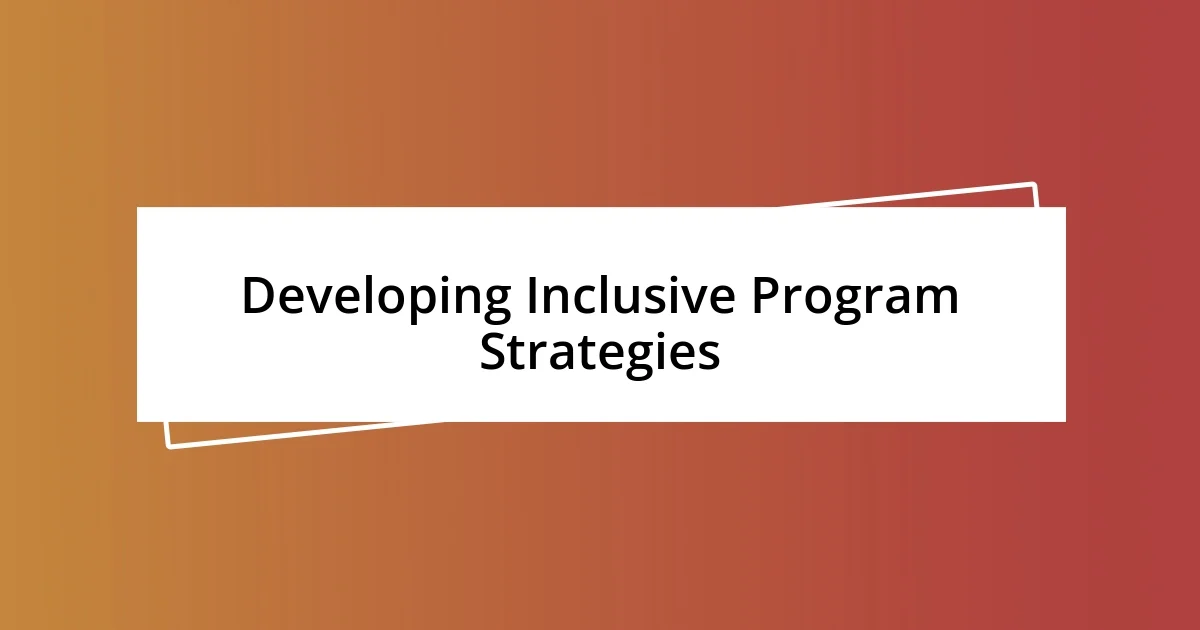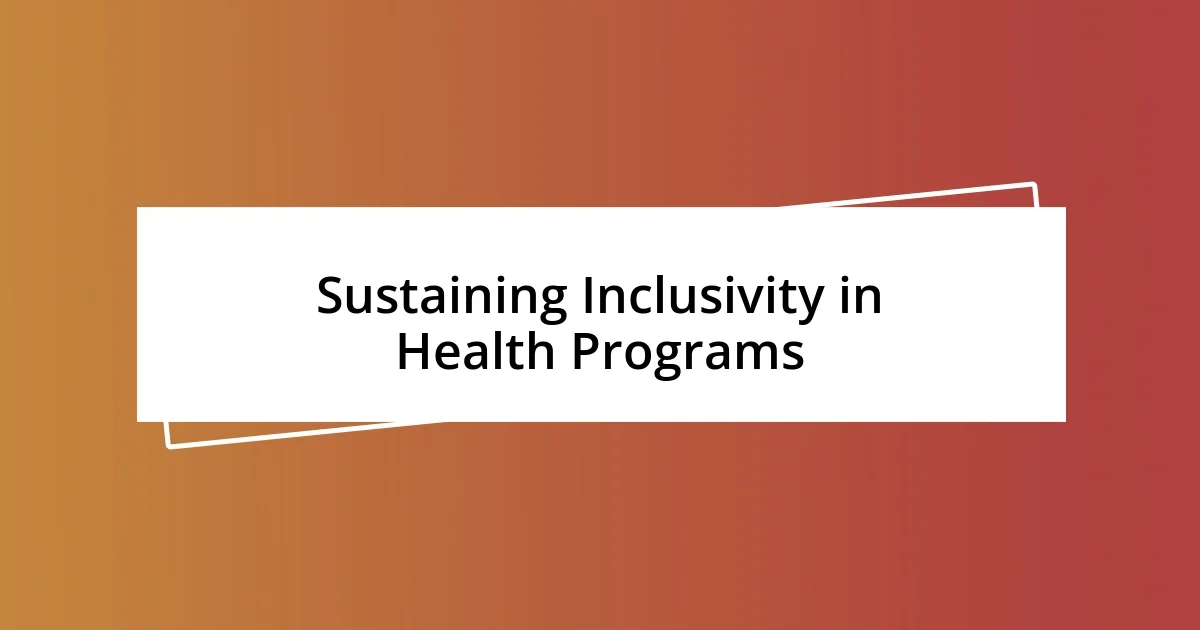Key takeaways:
- Engaging directly with community members through focus groups and workshops helps identify specific health needs and fosters a sense of ownership.
- Implementing inclusive strategies, such as advisory boards and flexible programming, enhances participation and ensures diverse perspectives are valued in health program development.
- Continuous evaluation and regular check-ins with the community strengthen inclusivity, ensuring that health programs evolve based on real experiences and feedback.

Understanding Inclusivity in Health Programs
Inclusivity in health programs means ensuring that everyone, regardless of their background, can access and benefit from the services offered. I once worked with a community health initiative where we aimed to engage individuals from diverse cultural backgrounds. The joy on their faces when they realized that their unique health needs were being acknowledged was truly heartwarming.
Imagine walking into a clinic and feeling invisible because no one understands your perspective or needs. That’s the reality for many. During my time coordinating outreach efforts, I learned that language barriers often prevent people from seeking help. By providing multilingual resources and culturally competent staff, we made strides towards making healthcare a welcoming space for everyone.
Inclusivity also means recognizing that everyone brings different experiences and challenges to the table. I remember organizing a workshop where participants shared their personal health journeys. Their stories highlighted not just the barriers they faced, but also the strength within their communities. How can we expect to create effective health programs if we don’t actively listen to those we serve? This dialogue is crucial for fostering a truly inclusive environment.

Assessing Community Needs and Gaps
To effectively assess community needs and gaps, I found that engaging directly with the community was essential. I remember hosting a series of focus groups where community members shared their thoughts on local health services. I was surprised by the range of opinions—some felt services were too generalized, while others expressed a complete lack of awareness about available resources. Listening to their insights not only helped me identify specific needs but also fostered a sense of ownership among participants.
Key areas to explore when assessing community needs and gaps include:
- Demographic Diversity: Understanding the cultural, socioeconomic, and age demographics of the community.
- Accessibility: Identifying barriers such as transportation, language, and physical access to healthcare facilities.
- Resource Awareness: Gauging the community’s knowledge of existing health services and programs.
- Health Outcomes: Analyzing data around chronic diseases, mental health issues, and preventative care statistics.
- Feedback Mechanisms: Establishing pathways for ongoing community feedback to adjust programs and services as needs evolve.
By prioritizing these elements, I was able to shape more inclusive health programs that truly resonated with community members. It was a learning experience that deepened my understanding of the intricacies involved in fostering inclusivity.

Developing Inclusive Program Strategies
Fostering inclusivity in health programs begins with developing effective strategies tailored to the unique needs of diverse communities. I recall a project where we created advisory boards made up of community members from different backgrounds. This approach not only brought authentic voices into the planning process but also cultivated a sense of belonging. When participants felt valued, their insights truly enriched the program.
Another important strategy involves the implementation of flexible programming. I once designed a series of workshops offered at various times and locations to accommodate different schedules. This small change significantly increased participation rates, allowing us to engage a broader audience. It’s fascinating how minor adjustments can sometimes lead to monumental improvements in accessibility and inclusivity.
Finally, measurement and continuous evaluation play a critical role in maintaining inclusive strategies. I remember setting up feedback loops where participants could anonymously share their experiences. The responses helped us identify what was working and what needed adjustment. This cycle of feedback not only improved current programs but also strengthened trust within the community.
| Strategy | Description |
|---|---|
| Advisory Boards | Community member engagement in planning and decision-making. |
| Flexible Programming | Offering services at various times/locations to increase accessibility. |
| Continuous Evaluation | Implementing feedback mechanisms to refine programs over time. |

Training Staff on Cultural Competence
Training staff on cultural competence is crucial in providing inclusive health programs. I remember the first workshop I facilitated on this topic, where we explored our own biases and assumptions. It was eye-opening to see my colleagues confront their perspectives, and it really underscored the importance of empathy in our work—after all, how can we serve diverse communities if we don’t understand their experiences?
I often use role-playing exercises to help staff walk in the shoes of different cultural perspectives. There was a moment during one of these activities when a team member took on the role of a non-English speaker trying to navigate our health system. The discomfort and frustration they expressed were palpable. Seeing firsthand how systemic barriers affect real people can ignite a deeper commitment to change. It made me ask—how can we ensure every staff member feels equipped to respond effectively to diverse needs?
Additionally, I integrate case studies from our community into training sessions, showcasing both successes and challenges. It’s important that staff not only learn theoretical concepts but also understand how they play out in practice. Reflecting on these real-life scenarios fosters a sense of urgency and responsibility. By sharing personal stories from our clients, it encourages staff to think critically about their roles. How often do we pause to consider the stories behind the statistics? Ultimately, these discussions lead to a more informed and compassionate approach to care.

Engaging Diverse Stakeholders Effectively
In my experience, engaging diverse stakeholders often starts with creating meaningful connections. For instance, I once organized a community dinner, where stakeholders from various backgrounds could break bread together. This informal setting encouraged candid conversations, allowing individuals to share their health concerns and expectations without any barriers. It was touching to witness how food became a bridge, fostering trust and openness among participants.
I also learned the importance of active listening during stakeholder meetings. I made it a priority to not only hear but truly understand the perspectives of each participant. In one instance, a local elder shared poignant stories about cultural health practices that had been overlooked. This moment reminded me that when we give space to authentic voices, we’re not just collecting data; we’re honoring experiences that profoundly shape a community’s health journey. Have you ever considered how different narratives could reshape your health programs?
Furthermore, I found that visual aids can significantly enhance engagement. During a community presentation, I used illustrative graphics to reflect the diversity of the population served. I noticed as I spoke, eyes lit up—people felt recognized in ways that words alone sometimes fail to convey. It made me think, how can we ensure our materials are as diverse as the stakeholders we aim to include? By embracing various cultural representations in our resources, we can turn information into empowerment.

Evaluating Program Impact on Inclusivity
Evaluating the impact of our programs on inclusivity requires looking beyond numbers. I vividly remember a focus group session where participants shared their experiences navigating our services. I was struck by the varying levels of understanding and accessibility they faced. It hit home—if the voices we serve don’t feel included, then our efforts may be falling short. How can we measure success if those metrics aren’t grounded in real experiences?
To deepen our analysis, I conducted a survey that included open-ended questions about participants’ feelings of inclusion. The feedback was eye-opening and, at times, heart-wrenching. One response from a participant stated they felt “invisible,” which served as a poignant reminder that inclusivity is not just about presence; it’s about genuine engagement. Reflecting on their words made me ask, are we truly listening to those we intend to help? This feedback was critical in shaping our follow-up actions.
As part of our evaluation, I initiated community feedback loops, allowing for ongoing dialogue. I set up a quarterly review where community members could voice their thoughts about the programs. The atmosphere during these gatherings was lively and emotional. Participants shared not only their concerns but also their hopes. It made me question—how often do we give people the chance to express what they really feel? These discussions have been transformative, guiding us to make changes that resonate and reverberate through the very fabric of our health programs.

Sustaining Inclusivity in Health Programs
Sustaining inclusivity in health programs isn’t just a checkbox; it’s an ongoing commitment that requires nurturing. I remember a particularly revealing workshop where participants from different cultures shared their visions for health services. One participant, a young mother, expressed her struggle in accessing language assistance during her appointments. Hearing her story, I felt a mix of empathy and urgency—how could we have let that happen? This moment ignited a shared purpose within our team: to ensure our services continuously evolve and adapt to the needs of everyone.
To maintain this inclusivity, I believe it’s crucial to establish regular check-ins with the very communities we serve. I initiated bi-annual community forums, where individuals can freely discuss their experiences and future health aspirations. During one session, an older gentleman passionately advocated for the inclusion of traditional healing practices alongside our Western approaches. His words carried weight, reminding me that inclusivity is about integration, not replacement. What if we could blend the best of both worlds? Thinking of those possibilities opened new avenues for collaboration that I hadn’t considered before.
Finally, I found that training staff on cultural competency is key for sustainability. There was a moment during a staff training when a team member shared their discomfort in addressing diversity. That conversation led to genuine growth. It resonated with me how openness in our own discomfort can foster a more inclusive environment. Are we fully equipped to embrace the richness of diversity in our teams as much as we do in our programs? It’s a continuous conversation—one that can guide our actions towards fostering a more inclusive culture, both inside our organization and in the communities we seek to serve.














